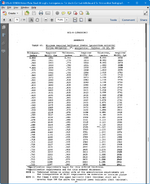harrytos23
Student
- Nov 6, 2024
- 22
Hi there!
I am trying to calculate how thick it needs to stop a 50 BMG AP caliber using AR500 plate. I used the formula that DoD published and I was able to get that it needs 0.554" plate to fully stop it.

My question now is, since we're using only 1 plate of 0.50" thk of ar500, in theory the bullet will go through the plate. I am wondering if there's an accurate way to calculate the velocity after passing through the first plate.
I am trying to calculate how thick it needs to stop a 50 BMG AP caliber using AR500 plate. I used the formula that DoD published and I was able to get that it needs 0.554" plate to fully stop it.

My question now is, since we're using only 1 plate of 0.50" thk of ar500, in theory the bullet will go through the plate. I am wondering if there's an accurate way to calculate the velocity after passing through the first plate.

